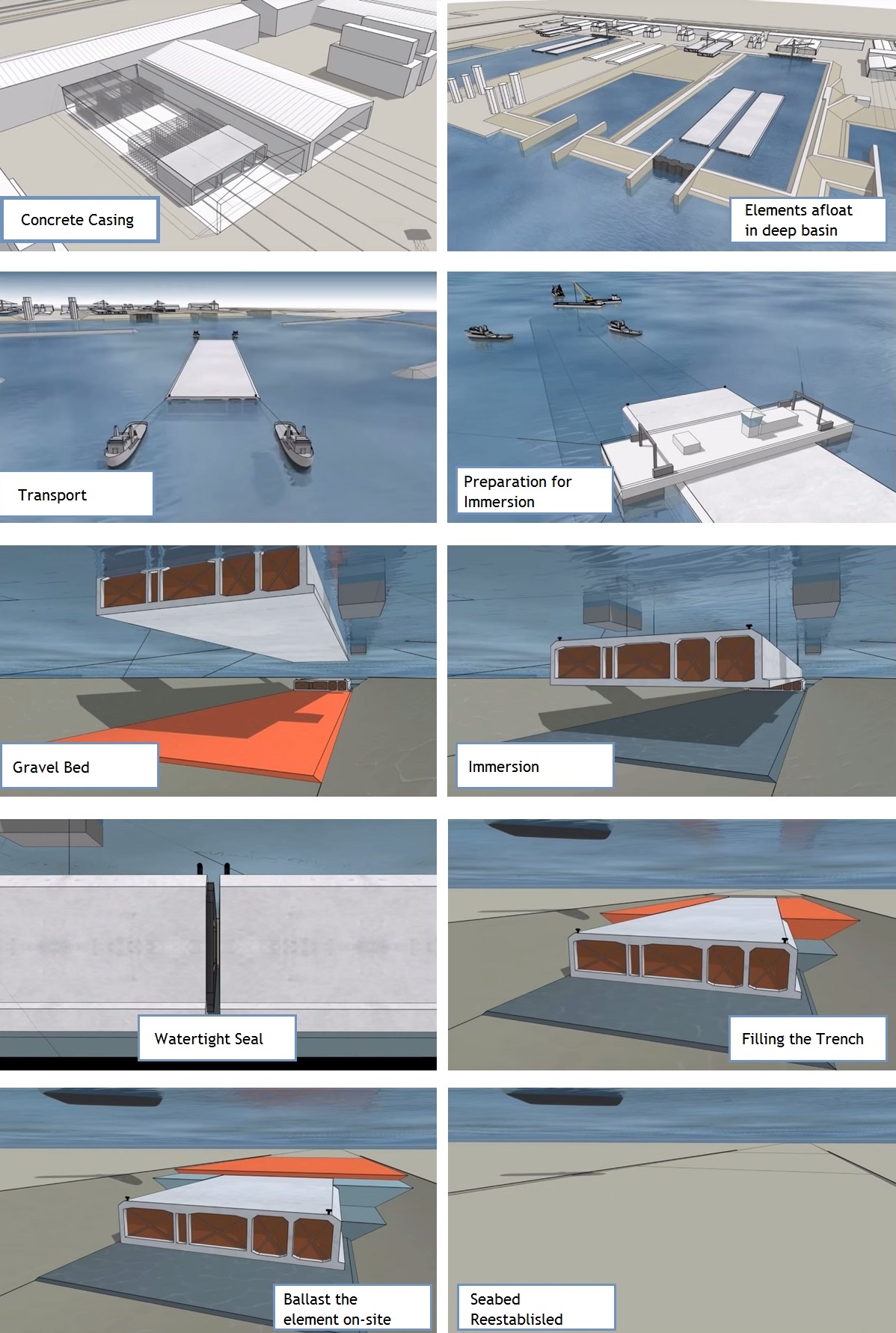Immersed Tube Tunnel
Immersed tube, also called Sunken Tube, technique of underwater tunneling used principally for underwater crossings. The method was pioneered by the American engineer W.J. Wilgus in the Detroit River in 1903 for the Michigan Central Railroad.
The immersed tunnel, also called Sunken Tube, is a tunnel construction method commonly used for crossing a body of shallow water. The method has been widely used for about 100 years, and more than 150 immersed tunnels have been constructed worldwide. They mainly serve as road or rail tunnels, but immersed tunnels are also used for water supply and electric cables.
The traditional European method for constructing an immersed tunnel is to establish one or more casting basins as open excavations, where the individual tunnel elements are constructed. Each tunnel element is composed of several segments.
When the elements are completed, they are sealed this temporary bulkheads are the casting basin is flooded one by one to their intended location, immersed into their final position on the seabed, are linked together. The tunnel is normally placedin in a pre-dredged trench in the seabed of the waterway. The connection to the land surface is normally connected to a cut and cover tunnel to overcome the level between the water and the land surface.
Summary of Activities
Casting basin and tunnel elements
- Constructing the casting basin for fabrication the tunnel elements
- Constructing the first batch of tunnel elements
- Construct the temporary water ballast system
- Seal the element with a temporary bulkhead
- Fill the casting basin (inundation)
- Remove the basin gate
- Floating, trimming and winching the elements out of the basin and transport them to the immersion site one by one or a temporary parking parking place
- Prepare the elements for the immersion process
Immersion
- Dredge the trench for the tunnel
- Construct a gravel bed at bottom of the trench
- Immerse the tunnel element to its final place in the dredged trench
- Connect the element by pumping and emptying water from of space between the bulkheads (Water pressure on the free end of the new element compresses and seal the rubber joint between the two elements)
- Backfill material is placed on the sides and over the tunnel , to fill the trench and permanently bury the tunnel
- Ballast the element on-site
- Establishing the closure joint and the tunnel is open
Tunnel installations
Parallel to immersion process, refurbishing of the the tunnel can be carried out in the elements already in place.
Stages of Construction
Advantages and disadvantages
The main advantage of an immersed tube is that they can be considerably more cost effective than alternative options – i.e. a bored tunnel beneath the water being crossed (if indeed this is possible at all due to other factors such as the geology and seismic activity) or a bridge. Other advantages relative to these alternatives include:
- Their speed of construction
- Minimal disruption to the river/channel, if crossing a shipping route
- Resistance to seismic activity
- Safety of construction (for example, work in a dry dock as opposed to boring beneath a river)
- Flexibility of profile (although this is often partly dictated by what is possible for the connecting tunnel types)
Disadvantages include:
- Immersed tunnels are often partly exposed (usually with some rock armour and natural siltation) on the river/sea bed, risking a sunken ship/anchor strike
- Direct contact with water necessitates careful waterproofing design around the joints
- The segmental approach requires careful design of the connections, where longitudinal effects and forces must be transferred across
- Environmental impact of tube and underwater embankment on existing channel/sea bed.
Tubes can be round, oval and rectangular. Larger strait crossings have selected wider rectangular shapes as more cost effective for wider tunnels.
Immersed Tube Tunnel Projects
- Michigan Central Railroad (first tunnel in 1910)Airport Express (MTR)
- Marmaray (world’s deepest immersed tunnel)
- Cross-Harbour Tunnel
- Eastern Harbour Crossing
- Sha Tin to Central Link
- Tsuen Wan Line
- Western Harbour Crossing
- Busan–Geoje Fixed Link
- Tokyo Bay Aqua-Line
- Detroit–Windsor Tunnel
- George Massey Tunnel
- Louis-Hippolyte Lafontaine Bridge–Tunnel
- 63rd Street Tunnel
- Baltimore Harbor Tunnel
- Chesapeake Bay Bridge–Tunnel
- Detroit–Windsor Tunnel
- Downtown Tunnel
- East Side Access
- Fort McHenry Tunnel
- Hampton Roads Bridge–Tunnel
- Midtown Tunnel (Virginia)
- Monitor–Merrimac Memorial Bridge–Tunnel
- Posey and Webster Street tubes
- Ted Williams Tunnel
- Transbay Tube
- Sydney Harbour Tunnel
Videos:
Source: ramboll.com; wikipedia.com; britannica.com

